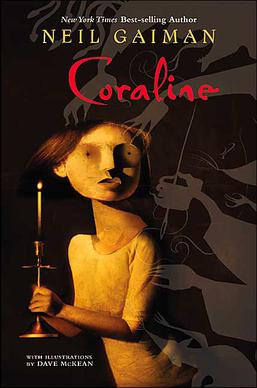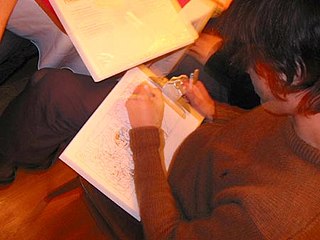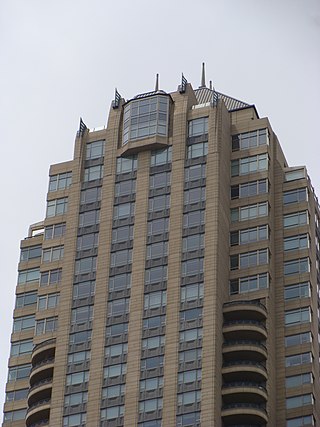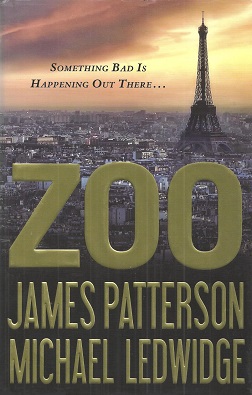
Ludwig Mies van der Rohe was a German-American architect, academic, and interior designer. He was commonly referred to as Mies, his surname. He is regarded as one of the pioneers of modern architecture.

Coraline is a 2002 British dark fantasy horror children's novella by British author Neil Gaiman. Gaiman started writing Coraline in 1990, and it was published in 2002 by Bloomsbury and HarperCollins. It was awarded the 2003 Hugo Award for Best Novella, the 2003 Nebula Award for Best Novel, and the 2002 Bram Stoker Award for Best Work for Young Readers. The Guardian ranked Coraline #82 in its list of 100 Best Books of the 21st Century. It was adapted as a 2009 stop-motion animated film, directed by Henry Selick under the same name.

Habitat 67, or simply Habitat, is a housing complex at Cité du Havre, on the Saint Lawrence River, Montreal, Quebec, Canada, designed by Israeli-Canadian-American architect Moshe Safdie. It originated in his master's thesis at the School of Architecture at McGill University and then an amended version was built for Expo 67, a World's Fair held from April to October 1967. Its address is 2600 Avenue Pierre-Dupuy, next to the Marc-Drouin Quay. Habitat 67 is considered an architectural landmark and a recognized building in Montreal.

An apartment, flat, or unit is a self-contained housing unit that occupies part of a building, generally on a single storey. There are many names for these overall buildings. The housing tenure of apartments also varies considerably, from large-scale public housing, to owner occupancy within what is legally a condominium, to tenants renting from a private landlord.

The Unité d'habitation is a modernist residential housing typology developed by Le Corbusier, with the collaboration of painter-architect Nadir Afonso. It formed the basis of several housing developments throughout Europe designed by Le Corbusier and sharing the same name.

A studio apartment, or studio condo also known as a studio flat (UK), self-contained apartment (Nigeria), efficiency apartment, bed-sitter (Kenya), or bachelor apartment, is a small dwelling in which the normal functions of a number of rooms – often the living room, bedroom, and kitchen – are combined into a single room.

The Margaret Mitchell House is a historic house museum located in Atlanta, Georgia. The structure was the home of author Margaret Mitchell in the early 20th century. It is located in Midtown, at 979 Crescent Avenue. Constructed by Cornelius J. Sheehan as a single-family residence in a then-fashionable section of residential Peachtree Street, the building's original address was 806 Peachtree Street. The house was known as the Crescent Apartments when Mitchell and her husband lived in Apt. 1 on the ground floor from 1925 to 1932. While living there, Mitchell wrote the bulk of her Pulitzer Prize-winning 1936 novel, Gone with the Wind.

Hard-Boiled Wonderland and the End of the World is a 1985 novel by Japanese author Haruki Murakami. It was awarded the Tanizaki Prize in 1985. The English translation by Alfred Birnbaum was released in 1991. A strange and dreamlike novel, its chapters alternate between two narratives—"Hard-Boiled Wonderland" and "The End of the World".

Marc Bell is a Canadian cartoonist and artist. He was initially known for creating comic strips, but Bell has also created several exhibitions of his mixed media work and watercoloured drawings. Hot Potatoe [sic], a monograph of his work, was released in 2009. His comics have appeared in many Canadian weeklies, Vice, and LA Weekly. He has been published in numerous anthologies, such as Kramers Ergot and The Ganzfeld.
David Helwig was a Canadian editor, essayist, memoirist, novelist, poet, short story writer and translator.

The Penelopiad is a novella by Canadian author Margaret Atwood. It was published in 2005 as part of the first set of books in the Canongate Myth Series where contemporary authors rewrite ancient myths. In The Penelopiad, Penelope reminisces on the events of the Odyssey, life in Hades, Odysseus, Helen of Troy, and her relationships with her parents. A Greek chorus of the twelve maids, who Odysseus believed were disloyal and whom Telemachus hanged, interrupt Penelope's narrative to express their view on events. The maids' interludes use a new genre each time, including a jump-rope rhyme, a lament, an idyll, a ballad, a lecture, a court trial and several types of songs.

John Connolly is an Irish writer who is best known for his series of novels starring private detective Charlie Parker.

Alissa York is a Canadian writer and the 1999 winner of the Bronwen Wallace Memorial Award. She lived in Winnipeg, Manitoba before settling in Toronto with her writer/filmmaker/publisher husband Clive Holden.

Lafayette Park is a neighborhood located east of Downtown Detroit. It contains a residential area of some 4,900 people and covers 0.07 sq mi.

Lucien Lagrange is an architect and a former partner at Skidmore, Owings & Merrill, who founded his own firm, named Lucien Lagrange Architects in 1985. The studio is a representative of New Urbanism and New Classical Architecture.

A.D.: New Orleans After the Deluge is a non-fiction graphic novel by cartoonist Josh Neufeld. Originally published as a webcomic, A.D. tells the stories of a handful of real-life New Orleans residents and their experiences during and after Hurricane Katrina. The graphic novel was a New York Times best-seller and was nominated for an Eisner Award and a Harvey Award in 2010. In addition, A.D. was selected for inclusion in The Best American Comics 2010.

The FOCSA Building is a residential and commercial block in the Vedado neighborhood of Havana, Cuba. At 121 meters (397 ft), it is the tallest building in Cuba. It was named after the contracting company Fomento de Obras y Construcciones, Sociedad Anónima, and the architects were Ernesto Gómez Sampera (1921–2004), Mercedes Diaz, and Martín Domínguez Esteban (1897-1970), who was the architect of the Radiocentro CMQ Building. The structural engineer was Luis Sáenz Duplace, of the firm Sáenz, Cancio & Martín, and professor of engineering at the University of Havana. The civil engineers were Bartolome Bestard and Manuel Padron. Gustavo Becquer and Fernando H.Meneses were the mechanical and electrical engineers, respectively. It is located on a site bordered by Calles 17 and M and Calles 19 and N in the Vedado.

Zoo is a science fiction thriller novel by James Patterson and Michael Ledwidge published in September 2012. The book made it to the New York Times bestseller list. A sequel, Zoo 2, by Patterson and Max DiLallo, was released on June 7, 2016, as a novella.

The López Serrano Building was the tallest residential building in Cuba until the construction of the FOCSA in 1956. Designed by the architect Ricardo Mira in 1929, who in 1941 who also designed La Moderna Poesia bookstore on Obispo Street for the same owner, it is often compared to the Bacardi Building in Old Havana built two years before the López Serrano Building because of their similarity in massing and central tower. The congressman, senator, and presidential candidate Eduardo Chibás was living on the fourteenth-floor penthouse when he committed suicide in August 1951 on the air at CMQ Radio Station.

A Ballet of Lepers: A Novel and Stories is a posthumous collection of fiction by Canadian author and singer-songwriter Leonard Cohen, consisting of the novella A Ballet of Lepers, fifteen short stories and a précis for a play. The collection was edited, with an afterword, by Alexandra Pleshoyano and was published in 2022.



















